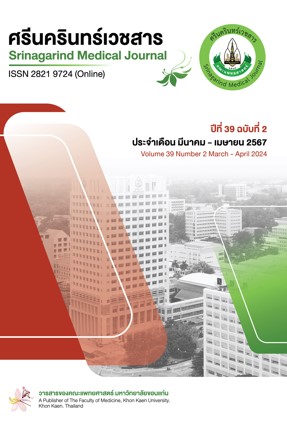ดัชนีภาวะช็อกทำนายการเสียชีวิตในผู้ป่วยเด็กที่ติดเชื้อในเลือดแบบรุนแรงและที่มีภาวะช็อก
คำสำคัญ:
เด็ก, ภาวะติดเชื้อในเลือดแบบรุนแรง, ภาวิช็อก, ค่าดัชนีภาวะช็อกบทคัดย่อ
หลักการและวัตถุประสงค์:ค่าดัชนีภาวะช็อก (shock index) เป็นค่าสัดส่วนของชีพจรใน 1 นาทีต่อค่าความดันโลหิตตัวบน ในผู้ป่วยเด็กที่มีภาวะติดเชื้อในเลือดแบบรุนแรงและที่มีภาวะช็อกพบว่าค่าดัชนีภาวะช็อกอาจบ่งชี้อัตราการเสียชีวิต การศึกษานี้มีวัตถุประสงค์เพื่อศึกษาความสัมพันธ์ของค่าดัชนีภาวะช็อกที่ผิดปกติต่อเนื่องภายหลังให้การวินิจฉัยที่ 6 ชั่วโมงกับอัตราการเสียชีวิต
วิธีการศึกษา:เป็นการศึกษาย้อนหลังแบบมีกลุ่มเปรียบเทียบ (retrospective cohort study) ในผู้ป่วยเด็กอายุตั้งแต่ 1 เดือน - 15 ปี ที่เข้ารับการรักษาในหอผู้ป่วยกุมารวิกฤตและมีภาวะติดเชื้อในเลือดรุนแรงและที่มีภาวะช็อก โดยผู้ป่วยทุกรายจะได้รับการคำนวณค่าดัชนีภาวะช็อกตั้งแต่ได้รับการวินิจฉัย จากนั้นผู้ป่วยที่มีค่าดัชนีภาวะช็อกที่ปกติจะถูกคัดออก ผู้ป่วยที่เหลือจะได้รับการคำนวณค่าดัชนีภาวะช็อกภายหลังให้การวินิจฉัยที่ 6 ชั่วโมงแล้วแบ่งออกเป็น 2 กลุ่ม คือ กลุ่มที่ค่าดัชนีภาวะช็อกกลับมาปกติ และกลุ่มที่ค่าดัชนีภาวะช็อกผิดปกติต่อเนื่องภายหลังให้การวินิจฉัยที่ 6 ชั่วโมง จากนั้นเปรียบเทียบอัตราการเสียชีวิตที่ 48 ชั่งโมงและอัตราการเสียชีวิตในโรงพยาบาลระหว่างทั้งสองกลุ่ม โดยค่าดัชนีภาวะช็อกที่ผิดปกติตั้งแต่ได้รับการวินิจฉัยในเด็กอายุน้อยกว่า 1, 1-6 และ 6-15 ปี มีค่ามากกว่าหรือเท่ากับ 1.98, 1.50 และ 1.25 ตามลำดับ ในขณะที่ค่าดัชนีภาวะช็อกภายหลังให้การวินิจฉัย ที่ 6 ชั่วโมงที่ผิดปกติ คือ ค่าดัชนีภาวะช็อกที่มากกว่าหรือเท่ากับ 1.66, 1.36 และ 1.30 ตามลำดับ
ผลการศึกษา:พบป่วยผู้ป่วย 60 ราย ที่มีภาวะติดเชื้อในเลือดรุนแรงและที่มีภาวะช็อกพบว่า 44 ราย มีค่าดัชนีภาวะช็อกที่ผิดปกติ ตั้งแต่ได้รับการวินิจฉัย โดยภายหลังให้การรักษาที่ 6 ชั่วโมง พบว่ามีผู้ป่วย 21 ราย ที่ค่าดัชนีภาวะช็อกกลับมาอยู่ในเกณฑ์ปกติ และมีอัตราการเสียชีวิตในโรงพยาบาลต่ำกว่ากลุ่มที่ค่าดัชนีภาวะช็อกที่ผิดปกติต่อเนื่องภายหลังให้การวินิจฉัยที่ 6 ชั่วโมง (AOR 0.07, 95% CI 0.01-0.36, p<0.001) ในขณะที่อัตราการเสียชีวิตที่ 48 ชั่วโมงไม่แตกต่างกัน นอกจากนี้พบว่า ภาวะภูมิคุ้มกันบกพร่อง (AOR 23.88, 95% CI 1.32-431.31, p=0.032) การติดเชื้อในโรงพยาบาล (AOR 45.21, 95% CI 2.28-898.55, p=0.012) รวมถึงค่าดัชนีภาวะช็อกที่ผิดปกติต่อเนื่องภายหลังให้การวินิจฉัยที่ 6 ชั่วโมง (AOR 86.59, 95% CI 3.01-2491.98, p=0.009) สัมพันธ์กับอัตราการเสียชีวิตในโรงพยาบาล
สรุป:ค่าดัชนีภาวะช็อกที่ผิดปกติต่อเนื่องภายหลังให้การวินิจฉัยที่ 6 ชั่วโมง สัมพันธ์กับอัตราการเสียชีวิตในโรงพยาบาล ดังนั้นผู้ป่วย ที่มีค่าดัชนีภาวะช็อกที่ผิดปกติต่อเนื่องภายหลังให้การวินิจฉัยที่ 6 ชั่วโมง อาจต้องการการประเมินและฟื้นฟูระบบไหลเวียนเพิ่มเติมเพื่อให้ได้ผลการรักษาตามเป้าหมาย
เอกสารอ้างอิง
Weiss SL, Peters MJ, Alhazzani W, Agus MSD, Flori HR, Inwald D, et al. Surviving sepsis campaign international guidelines for the management of septic shock and sepsis-associated organ dysfunction in children. Pediatr Crit Care Med 2020;21(2):52–106. doi: 10.1097/PCC.0000000000 002198.
Locharoenrat S. Epidemiology and outcomes of pediatric severe sepsis & septic shock in Queen Sirikit National Institute of Child Health [dissertation]. Bangkok, Queen Sirikit National Institute of Child Health; 2016.
Benjamin J. Shock. In: Jacquelyn L, Banasik, Copstead LC, editors. Pathophysiology. 6thed. St. Louis, MO: Saunders; 2018:434-50.
Gupta S, Alam A. Shock index-a useful noninvasive marker associated with age-specific early mortality in children with severe sepsis and septic shock: age-specific shock index cut-offs. J Intensive Care Med 2020;35(10):984–91. doi: 10.1177/088506 6618802779.
Goldstein B, Giroir B, Randolph A. International pediatric sepsis consensus conference: definitions for sepsis and organ dysfunction in pediatrics. Pediatr Crit Care Med 2005;6(1):2-8. doi: 10.1097/01. PCC.0000149131.72248.E6.
Gaies MG, Gurney JG, Yen AH, Napoli ML, Gajarski RJ, Ohye RG, et al. Vasoactive-inotropic score as a predictor of morbidity and mortality in infants after cardiopulmonary bypass. Pediatr Crit Care Med 2010;11(2):234–8. doi: 10.1097/PCC.0b013e 3181b806fc.
Lopez-Reyes CS, Baca-Velazquez LN, Villasis-Keever MA, Zurita-Cruz JN. Shock index utility to predict mortality in pediatric patients with septic shock or severe sepsis. Bol Med Hosp Infant Mex 2018;75:192–8. doi: 10.24875/bmhime. m18000041.
Rivers E, Nguyen B, Havstad S, Ressler J, Muzzin A, Knoblich B, et al. Early goal-directed therapy in the treatment of severe sepsis and septic shock. N Engl J Med 2001;345(19):1368-77. doi: 10.1056/ NEJMoa010307
Rousseaux J, Grandbastien B, Dorkenoo A, Lampin ME, Leteurtre S, Leclerc F. Prognostic value of shock index in children with septic shock. Pediatr Emerg Care 2013;29(10):1055–9. doi: 10.1097/PEC.0b013e3182a5c99c.
Yasaka Y, Khemani RG, Markovitz BP. Is shock index associated with outcome in children with sepsis/ septic shock?. Pediatr Crit Care Med 2013;14(8): 372-9. doi: 10.1097/PCC.0b013e3182975eee.
Gupta S, Alam A. Shock index is better than conventional vital signs for assessing higher level of care and mortality in severe sepsis or shock. Am J Emerg Med 2021;46:545–9. doi: 10.1016/j. ajem.2020.11.014.
Davis AL, Carcillo JA, Aneja RK, Deymann AJ, Lin JC, Nguyen TC, et al. American college of critical care medicine clinical practice parameters for hemodynamic support of pediatric and neonatal septic shock. Crit Care Med 2017;45(6):1061–93. doi: 10.1097/CCM.0000000000002425.
Menon K, Schlapbach LJ, Akech S, Argent A, Biban P, Carrol ED, et al. Criteria for pediatric sepsis-a systematic review and meta-analysis by the pediatric sepsis definition taskforce. Crit Care Med 2022;50(1): 21-36. doi: 10.1097/CCM.0000000000 005294.
ดาวน์โหลด
เผยแพร่แล้ว
รูปแบบการอ้างอิง
ฉบับ
ประเภทบทความ
สัญญาอนุญาต
ลิขสิทธิ์ (c) 2024 ศรีนครินทร์เวชสาร

อนุญาตภายใต้เงื่อนไข Creative Commons Attribution-NonCommercial-NoDerivatives 4.0 International License.




